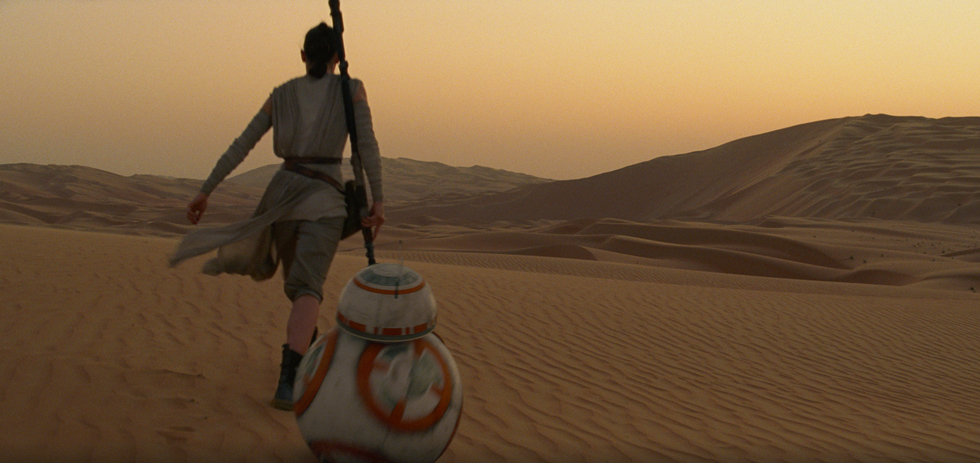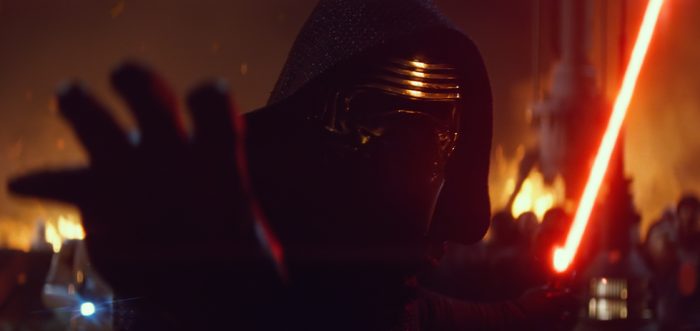
“Nostalgia” is probably the most efficient way to describe popular cinema in 2015, with long dormant franchises returning to the forefront of popular culture. We had Jurassic World – a sequel no one really asked for – breaking box-office records, while Mad Max: Fury Road – a sequel that you never would have expected after Beyond Thunderdome – is already being labelled as the defining movie of 2015.1 Sure, it’s only been a decade since our last journey to the galaxy far, far away with George Lucas’ Revenge of the Sith but The Force Awakens leapfrogs that: it’s a direct sequel to a film that’s over thirty years old.
This nostalgic obsession is why J.J. Abrams was the perfect choice to helm the seventh Star Wars film. It’s no secret that George Lucas wore his influences on his sleeve when creating A New Hope, with visuals and character archetypes lifted, almost directly at times, from the westerns, samurai films and sci-fi serials that he grew up watching. Abrams is no stranger to this process2 and in The Force Awakens it’s obvious that he, too, is channeling the films that have influenced him. As it happens, those particular films are the original Star Wars trilogy.
The Force Awakens is an incredibly referential film, borrowing a lot from the original trilogy, particularly the broad plot points of A New Hope. Both films open on a desert planet where a droid carrying important data comes across an orphan, there’s an escape from an Imperial/First Order ship and the entire third act is devoted to destroying a giant space laser. This is the film’s clearest weakness; apart from new characters and renamed factions, everything is pretty much the same as it ever was. One of the biggest problems of George Lucas’ much maligned prequel trilogy was its over-reliance on referencing the minutiae of his original, to the point that throwaway lines like “I’ve got a bad feeling about this” became cartoonish catchphrases. They felt forced, as though Lucas was desperately trying to pander to Star Wars fans in the laziest way possible.3 That said, while Abrams, along with the screenwriting team of Lawrence Kasdan and Michael Arndt, are by no means innocent of pandering,4 they’ve updated and altered enough to make The Force Awakens stand on its own two legs. If A New Hope was Bob Dylan’s original “All Along the Watchtower”, then The Force Awakens is the Jimi Hendrix cover. For scale, the prequel trilogy is Limp Bizkit’s cover of “Behind Blues Eyes.”
Abrams already warmed up for a Star Wars movie with his Star Trek reboot franchise. Now, though, he gets to actually play with the real toys instead of pretending. The Force Awakens is beautifully shot by Star Trek cinematographer Dan Mindel, and every environment both feels and looks lush and tangible. This is most prevalent in a sequence which sees our main heroes enter a cantina, followed by a panning shot of all its patrons that demonstrates just how real and unique every single creature is. The worlds feel lived in, with characters actually interacting with their environment instead of awkwardly posturing in front of a green-screen.
Also a pleasant surprise is the amount of spaceship battles. The first dog-fight on Jakku, for example, is one of the film’s finest moments, and possibly even the best ship-on-ship battle in the entire series. In its pacing, though, Abrams does try to cram a bit too much plot into the film, made particularly apparent in his rushed third act.5 Despite the already long runtime, The Force Awakens may have benefited from slowing down a bit, allowing the film to breathe in between its many action beats. It’s the type of film that needs a big, final action sequence, but the sudden inclusion and destruction of the Starkiller base doesn’t feel like a natural progression, but more like something that the movie had to be made around. There’s a goofy chase sequence during the introduction of Han Solo and Chewbacca to Finn and Rey that could have definitely been cut from the film, as it adds nothing to the film except a few more funny Solo moments – and there are plenty of those.

For a series known for its poor representation of both women and people of colour, Rey (Daisy Ridley) and Finn (John Boyega) are incredibly interesting characters, who, while possessing a few familiar traits, aren’t characters we’ve necessarily seen in this series before.6 Oscar Isaac, as pilot Poe Dameron, also turns in an entertaining performance, though his character just seems to be the new Wedge Antilles. This is probably the biggest edge The Force Awakens has over the prequel trilogy. Instead of being direly one-dimensional, they feel like real, flesh-and-blood characters with actual motivations and goals.7 We see a genuine friendship bloom between Finn and Poe, whereas the prequels tell us that Obi-Wan and Anakin are best friends without actually showing it. We grow to care for them instead of being told we should like them. Finn and Rey are just beginning their journey, and I can’t wait to see where it takes them.
Of all the new characters, Kylo Ren is the most interesting. Adam Driver does a great job as a wannabe Darth Vader – he’s got the menacing design and stature down pat, with powerful Dark Side abilities to match, but it’s obvious he’s a kid wearing granddad’s shoes. His imposing villainy is undermined each time he throws a tantrum when things don’t go his way. It’s an internal struggle, one almost representative of The Force Awakens as a whole, which aims to live up to an iconic figure and continue its legacy.
That said, the film doesn’t make use of all its new characters as well as it could. Lupita Nyong’o is wasted as space pirate Maz Kanata, a role that could’ve been filled by pretty much anyone. Gwendoline Christie’s character Captain Phasma also feels underused, and having her act as Boba Fett 2.0 comes off as a weird referential joke.8 The new Emperor Palpatine figure, Supreme Leader Snoke (Andy Serkis), doesn’t come off as menacing as Abrams probably intended, feeling more like a device for exposition than an actual character. In saying this, apart from Harrison Ford’s iconic Han Solo – who gets a surprising amount of screentime – the original trilogy’s heroes get the right amount of exposure. Carrie Fisher’s Leia, now a Resistance General, now acts as a quest giver for the new heroes. Her performance is nothing spectacular, but it’s nice to see where that character is 30 years later. They don’t feel intrusive; they obviously need to be in the film, yet they never steal the focus away from the new cast.
The Force Awakens was never going to be as instantly overwhelming or as special as the original films, which have surpassed the ranks of cult status to become god-like in modern popular culture, but it’s the Star Wars film we’ve been waiting over thirty years to see. For the first time in decades we finally have a Star Wars movie that actually feels like a Star Wars movie.9 It’s exactly the film you expect it to be, and that’s more than enough for now.
Around the Staff
| Conor Bateman | |
| Dominic Barlow | |
| Jeremy Elphick | |
| Brad Mariano | |
| Kenneth Kriheli | |
| Jaymes Durante | |
| Dominic Ellis | |
| Ian Barr | |
